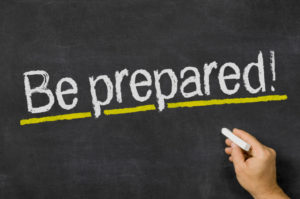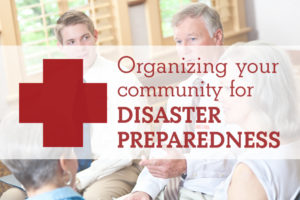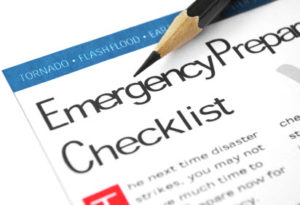 September is National Preparedness Month – a reminder that the time to plan for a disaster is before it happens – don’t wait until it’s too late! If you had to leave your home or place of work without much warning, would you know what to take with you?
September is National Preparedness Month – a reminder that the time to plan for a disaster is before it happens – don’t wait until it’s too late! If you had to leave your home or place of work without much warning, would you know what to take with you?
Your ability to recover from an emergency tomorrow depends on the planning you do today. By training to respond in the event of a disaster, you can help first responders in our community by acting quickly. The goal of National Preparedness Month is to increase the number of individuals and communities that engage in preparedness actions at home, work, or school.
Preparedness for your family:
Preparing your family for a disaster can start with a simple conversation. Make an emergency communications plan and build a grab-and-go emergency kit.
Make an emergency communications plan:
Your family may not be together if a disaster strikes. Make a plan to know how you’ll contact one another and reconnect if separated. Planning in advance will help ensure that all members of your household will know how to reach each other. Remember that during a disaster – text is best. A text message may get through when a phone call will not – text messages may also save and automatically send as soon as capacity becomes available.
Creating an emergency communications plan starts with a few easy steps:
- Create a paper copy of the contact information for your family and other important people or places, such as doctors, schools and medical facilities.
- Make sure everyone has a copy of the contact information in their purse, backpack, or wallet. You should also post a copy in a central location in your home.
- Have regular household meetings to review and practice your plan.
Prior to an emergency:
- Sign up for local emergency alerts in your area. The St. Mary’s County Government CodeRED Emergency Notification System is a free telephone communication service that can quickly contact residents with critical information and instructions for actions that should be taken in case of a significant incident or event.
- Check your house insurance coverage regularly to see if any items need to be updated, such as flood insurance.
- Learn your evacuation zone and have an evacuation plan.
- Plan financially for the possibility of a disaster – keep cash on hand in case of emergencies since ATMs may not be accessible or functioning.
- Place copies of important documents in waterproof bags to protect against damage. Important documents may include birth certificates, bank account numbers, deeds, credit card numbers and companies, insurance policies, Medicare information, and passports.
- Learn where shut-off valves for water, electric, and gas are located.
- Practice evacuating in the car with your pets so they’re more comfortable in case of an emergency. Make sure their emergency kit includes food, water, medicines and medical records, and a collar with ID tag and harness or leash for each pet. Never leave a pet behind or chained outdoors during an emergency – they may get lost, injured, or worse! Find names of pet-friendly hotels since many emergency shelters cannot accept pets.
Build an emergency kit:
Put your kit in one or two easy-to-carry plastic bins or duffel bags. Basic items for your kit should include a minimum three-day supply of the following:
- One gallon of water per-person per-day
- Ready-to-eat canned foods (don’t forget foods for family members with special dietary needs), along with paper cups, plates and plastic utensils
- First aid kit (make sure to pack at least a three-day supply of medications)
- Tools and supplies (including flashlights, battery operated radio, extra batteries, and non-electric can opener)
- Clothing and blankets/sleeping bags
- Personal hygiene products such as soap and toilet paper
- Don’t forget items for any special needs your family may have (such as infant formula and diapers, insulin, denture needs, and eyeglass or contact lens supplies)
Preparedness for your neighbors and community:
 Almost half of Americans expect to rely on their neighbors after a disaster. Life-threatening emergencies can happen fast, and emergency responders may not be nearby. You may be the help until professional help arrives – you may be able to save a life by taking simple actions immediately. You and your neighbors can take “Until Help Arrives” training, or learn basic first-aid skills and CPR to keep people with life-threatening injuries alive until professional help arrives.
Almost half of Americans expect to rely on their neighbors after a disaster. Life-threatening emergencies can happen fast, and emergency responders may not be nearby. You may be the help until professional help arrives – you may be able to save a life by taking simple actions immediately. You and your neighbors can take “Until Help Arrives” training, or learn basic first-aid skills and CPR to keep people with life-threatening injuries alive until professional help arrives.
Preparedness for your place of work or school:
Make sure your school or place of work has emergency procedures in place in the event of an emergency.
- Keep an emergency kit at work or in your dormitory in case you are unable to return home after a disaster.
- Know how to get in touch with family and friends if phones are down. Text instead of call and post yourself as safe on social media, if possible.
- If you can’t get in touch with family or friends, register yourself as “Safe and Well” on the American Red Cross’ website.
For more information about disaster preparedness and building an emergency kit or family communications plan, visit www.Ready.gov.


